For many Americans, doughnuts are a much-loved, feel-good food. More than 193 million people ate these hand-held treats in 2017, and a reported 10 billion doughnuts are made in the U.S. annually. Today, system-wide sales for Dunkin’ Brands—which includes Dunkin’ Donuts and ice cream maker Baskin-Robbins—exceed $11.1 billion from more than 20,000 locations worldwide. Dunkin’ Donuts itself is found in 46 countries.
In New England especially, Dunkin’ customers tend to be loyal and maintain a strong, emotional connection to the company, says Kate Jaspon ’98, CFO for Dunkin’ Brands. Jaspon, who joined the company as an assistant controller in 2006 after auditing it in her previous job with KPMG, remembers childhood visits with her family to Dunkin’ to pick up Munchkins. Professionally, she was drawn to the company because of its iconic branding and growth potential. As a Babson graduate and the daughter of a small business owner, she also liked Dunkin’s all-franchise model and the opportunity to work with entrepreneurs growing small businesses.
Given the company’s entrepreneurial bent and penchant for innovation, perhaps it’s not surprising that so many Babson alumni work for Dunkin’ Brands. It’s not unusual to attend a meeting and discover that the person sitting next to you is a Babson graduate, Jaspon says. She and fellow alumni say the world of doughnuts and coffee is fiercely competitive. Staying ahead of competitors in this space requires fresh, innovative ideas, Justin Unger adds. “When we’re trying to solve a business challenge,” he says, “the entrepreneurial mindset is a valuable asset.” But franchise owner Blum also likes to remind his employees to smile and keep it light. “There’s a lot of work to do, and it’s very hard work,” he says, “but this is a fun business.”
The World of Franchises
After graduating from Babson, Blum worked in commercial banking in Boston for nearly 20 years, eventually leading the franchise-lending group for Sovereign Bank, where he backed a variety of franchises, including Dunkin’ Donuts. “The Dunkin’ franchisees I did business with were some of the nicest people you would ever meet,” Blum says. “I think part of me wanted to be part of that community.” Growing up with a father who owned a small business, Blum often wondered if he should go into business for himself as well.
In 2005, one of his clients, John Batista, who had owned Dunkin’ franchises for decades, asked Blum to partner with him and expand Dunkin’s reach in the Cleveland area. Blum and his wife, Gerri, who was then home with the couple’s four kids, decided to say yes. Gerri spent a year in Dunkin’ stores, learning the ins and outs of operations, while Blum wrapped up his bank job and began his own six months of hands-on training. They moved the family to Ohio and opened their first location in Cuyahoga Falls in November 2007. Blum remembers a lot of anxiety and doubt. But when the banking industry tanked in 2008, he was relieved that he had left, and by the five-year mark he and Gerri felt confident in their decision to join Dunkin’. Blum’s brother, Bob, eventually joined the business as a partner, and they now own 26 Dunkin’ locations.
For many Dunkin’ franchisees, doughnuts are a family affair. Consider Alex DiPietro ’09, who met his wife, Lindsey ’08, at Babson. After working in technology sales for several years, DiPietro went into business with his wife’s father, Carlos Andrade, an immigrant from Portugal who followed in his brother’s footsteps and purchased his first Dunkin’ franchise in the Boston area roughly 50 years ago. Over the decades, the Andrade brothers have drawn many more relatives into the business. “I always joke that my wedding ran on Dunkin’,” DiPietro says. “We had 300 people there, and pretty much all of them were franchisees.”
Since DiPietro joined his father-in-law’s business, they’ve expanded from 70 stores to 130, making them one of Dunkin’s largest franchisees. DiPietro manages 13 locations in Massachusetts, 10 in Connecticut, and 13 in Florida. His responsibilities range widely, from overseeing daily operations and building maintenance to staking out new properties and growth opportunities. He believes more people should consider owning franchises. “Coming out of a great school like Babson, everyone wants to create a product or build their own business,” DiPietro says. “But I think franchises are overlooked as an opportunity to own a business. An established brand has already done a lot of heavy lifting, and it allows people to get their feet wet.”
Dunkin’s franchise agreements are typical in the franchise world, explains CFO Jaspon. Franchisees pay an upfront fee per location that is good for 20 years. They also pay ongoing 5.9 percent royalties to Dunkin’ Brands each week, along with a 5 percent fee based on top-line sales, which goes toward advertising. In many regions, multiple owners invest together in cooperative kitchens where doughnuts are made daily and delivered to stores, keeping the process efficient and consistent.
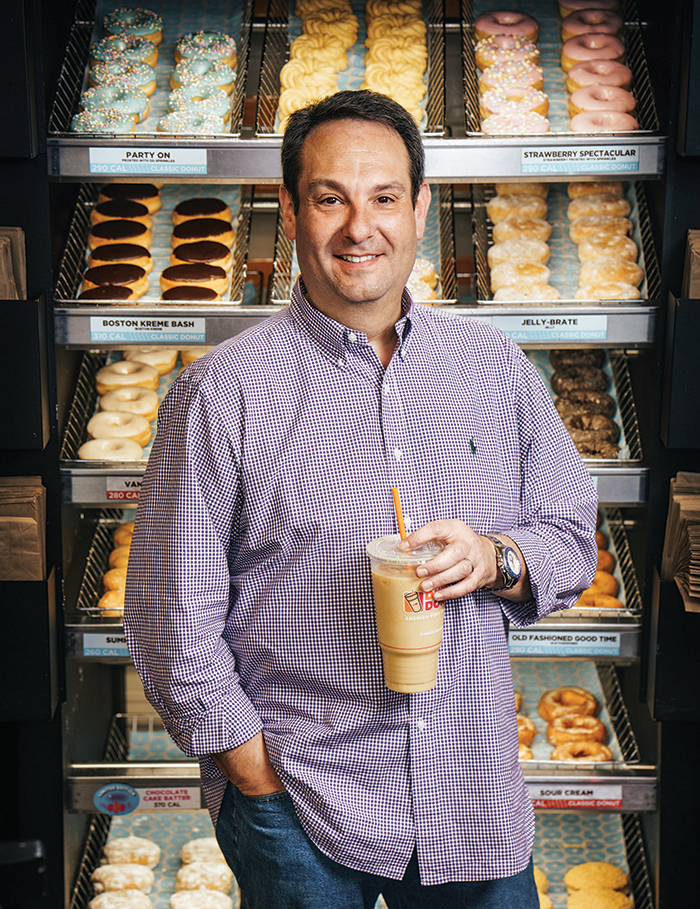
Photo: Gene Smirnov
Franchise owner Adam Goldman ’89 at his West Orange, New Jersey, store
After a significant career in corporate America, including many years as an executive consultant, Adam Goldman ’89 began exploring the possibility of owning a business. “I got tired of being on a plane from Monday through Friday,” he says. “I wasn’t finding any great manufacturing businesses for sale, but I was going to Dunkin’ Donuts every day for my coffee.” Goldman felt the store near him in West Orange, New Jersey, didn’t run as well as it should and thought he could probably do better. With his interest piqued, he began researching franchise opportunities. Dunkin’ Donuts stood out in part because it allowed franchisees some latitude in their entrepreneurial tactics. So in 2009, Goldman purchased two stores in nearby Paterson. He hired more staff, bought updated equipment, and launched new initiatives, such as delivering doughnuts to local offices.
He then purchased a third location in West Orange, but the store felt small and parking was lousy. So Goldman operated out of that Dunkin’ while building a new store just 150 yards away, this one with a drive-thru, ample parking, a kitchen, and quadruple the seating. The new location opened in December 2015. “We operated the old store until 12:30 p.m., and then opened the drive-thru at the new place at 12:31 p.m., and never skipped a beat,” Goldman says.
In an effort to control operating costs at this larger facility, he outfitted the store with green technologies, including LED lighting, high-efficiency heating and cooling, an in-house “biodigester” that breaks down food wastes to produce energy, and an electric-vehicle charging station in the parking lot. The store won Dunkin’s “Green Elite” designation, and Goldman says the West Orange community has loved the new location. “Dunkin’ told us to expect a 30 percent bump in sales due to the drive-thru,” Goldman says, “but we actually had an 85 percent bump in sales.”
Location, Location, Location
The success of Goldman’s stores (he and his wife, Karen, now own four) points in part to the importance of wisely chosen locations. Blum in Ohio prefers to locate his stores on Monday-to-Friday commuter routes, just before the driver hits the highway. “Right turn in, right turn out, you’re on your way,” he says, adding that he also considers commuter psychology. “We prefer to be at the beginning of the commute as opposed to the end. If you’re five minutes late heading out the door for your 30-minute commute, and you know we’re fast, you’ll stop for a cup of coffee even though you’re running late, thinking that you might be able to make it up,” Blum says. “But if it’s at the end of your commute, and you’re five minutes late, you’re not stopping.”
The Babson franchisees say fast but friendly service is critical, particularly at the drive-thru window. Goldman’s West Orange drive-thru serves 130 to 140 cars an hour during the morning rush. Blum coaches his teams to assume that most customers are late to work. Dunkin’ has less of a “sit-and-stay” mentality than other coffee spots, adds DiPietro, and focuses more on moving people in and out. “Our customers have to get to work, have to get the kids to school, and have to move along with their day,” he says. “Speed of service is imperative in our business.”
Competition comes from all directions. The U.S. doughnut universe includes such contenders as Krispy Kreme, Canadian chain Tim Hortons, and local bakeries. But the competition grows especially fierce around coffee and other beverages, which account for more than 60 percent of Dunkin’s U.S. sales. The competition comes from chains such as Starbucks, quick-service restaurants such as McDonald’s, local coffee shops and high-end “beaneries,” and the so-called “C” stores, or gas and convenience businesses, such as Cumberland Farms. “They’re using coffee and other beverages to drive people into their stores,” Jaspon says. “They’re actually giving the product away for very cheap, which has given us a whole new form of competition to deal with.”
Dunkin’ also competes with the coffee maker at home and at the office, Blum notes. “There are so many choices for customers to get a cup of coffee, so we have to execute at as high a level as possible,” he says. In part, this means delivering coffee just the way the customer likes it. “For every medium black coffee there are 30 people who will order it highly customized, say with one Splenda, three creams, and a pump of caramel swirl,” Blum says. “People are very particular about how they want their coffee.”
Perhaps the biggest challenge for Dunkin’ franchisees is the struggle to find good employees. Given the low national unemployment rate, employers face a severe labor shortage. A declining number of high school students—previously a reliable source of workers—apply as well, exacerbating the problem. “Applications are way, way, way down,” Blum says, “and not everyone’s cut out for customer service. I have more anxiety about staffing than any other issue. My wife will tell you: As we get closer to an opening, I get crankier and more and more anxious.” Each new location typically requires 10 to 30 employees, depending on store size and volume.
In the search for solutions, Blum and his brother have traveled to Washington to lobby on franchisee issues such as immigration reform, with the hope that increasing the number of people coming from other countries can expand the pool of available labor. Goldman notes that a large number of his employees are from Bangladesh. “I have brothers, sisters, uncles all from the same families working for me,” says Goldman, whose franchises experience unusually low staff turnover. Most employers are desperate for reliable help, Blum says. “Talk to people in other industries that support us: the carpet guy, the window guy, the landscaper, the snowplow guy. They’re all in the same boat,” he says. “Everyone’s just scratching their heads and struggling.”
We Are Family
Any time multiple franchise owners get together, staffing difficulties are a frequent conversation topic. “We share each other’s pain,” Blum says, who adds that he and other franchisees typically see one another as allies rather than competitors. Goldman says, “In general, we talk, we share ideas, we help each other out. We are more family than competitors.”
That spirit of cooperation also exists at the corporate level, where partnering with franchisees is built into the organization model. For example, Dunkin’ Brands maintains a formal committee system made up of franchisees elected by their peers. Regional Advisory Committees (RACs) elect representatives to the Brand Advisory Council (BAC), which meets with the corporate team in Canton, Massachusetts, four times a year. The BAC also has subcommittees of franchisees to focus on such areas as marketing, restaurant operations, profitability, and technology. “The meetings are useful, as you get to meet and interact with the brand leadership,” says Blum, currently co-chair of the Midwest RAC and a member of the BAC. “You don’t always get exactly what you want, but you get to share your ideas and opinions in a constructive format.”
Franchisees are central to Dunkin’ Brands, which is 100 percent franchisee-owned, notes CFO Jaspon. Dunkin’ does not run any stores itself, which contributes to a smaller-than-usual corporate structure and allows for corporate-franchisee teamwork. “Franchisees are an integral part of every decision we make,” says Anh-Dao Kefor in integrated marketing.
Corporate guides strategy, develops and rolls out new products and promotions, manages advertising budgets, and handles product nutrition information and regulatory compliance, for example, but it solicits feedback from franchisees along the way. This occurs through the committee system and in more informal ways, too. “I might pick up the phone to franchisees and say, ‘Hey, I want to run something by you,’” Kefor says, asking, for instance, about their initial reaction to a new product concept or promotion.
“People think of us as a very large corporate organization,” Jaspon says, “but it’s really a conglomerate of small business owners.” In addition to working with franchisees, Jaspon oversees the team that handles financial planning and analysis, business analytics, and tax and accounting. Her daily duties include managing interactions with the Securities and Exchange Commission and investors, and she handles the finance side of all business functions. “Every day is different,” she says. “I could be in meetings with franchisees, meetings with our investors, or leading the finance group in the office.”
In Kefor’s daily work, she views franchisees as one of the customers her integrated marketing team serves, in addition to the field teams for marketing and operations, who drive the communication and execution of upcoming programs. Kefor’s first roles with Dunkin’ were marketing positions for Baskin-Robbins, and over the next decade she eventually moved into strategic initiatives and operating systems roles, serving as the bridge between the Baskin-Robbins brand and franchisees. “I would spend my commutes every day on the phone with our franchisees, getting to know them, understanding their stores, basically building trust and credibility,” Kefor says.
At the beginning of 2018, Kefor took on her current role with Dunkin’ Donuts, leading the four-person team that oversees the 12- to 18-month marketing calendar for beverages. Her team develops monthly programs to match the season (say, Girl Scout-inspired flavors during the Scouts’ cookie season), partnering with the advertising, loyalty, public relations, and media teams to develop campaigns. Sharing the story and details of each program with franchisees keeps Kefor and her team on their toes. “We’re not developing a product and taking it straight to the consumer,” she says. “We have the opportunity to collaborate with our franchisee partners first. We want them to be advocates and ambassadors, and that requires a strong business case and due diligence on our end to get them on board. I’ve learned that you have to be proactive about franchisees’ concerns.”
Drawn in by Doughnuts
When Nisha Munshi, MBA’15, meets new people, there’s often a funny moment when they ask what she does for work. “When I explain that I’m a registered dietitian for Dunkin’ Donuts, they often look at me with a slightly confused face,” she says. Munshi earned an undergraduate degree in nutrition sciences and went on to Massachusetts General Hospital to complete a dietetic internship. She completed several clinical rotations in different areas of nutrition and discovered that she liked the broad reach she could have while working for food companies.
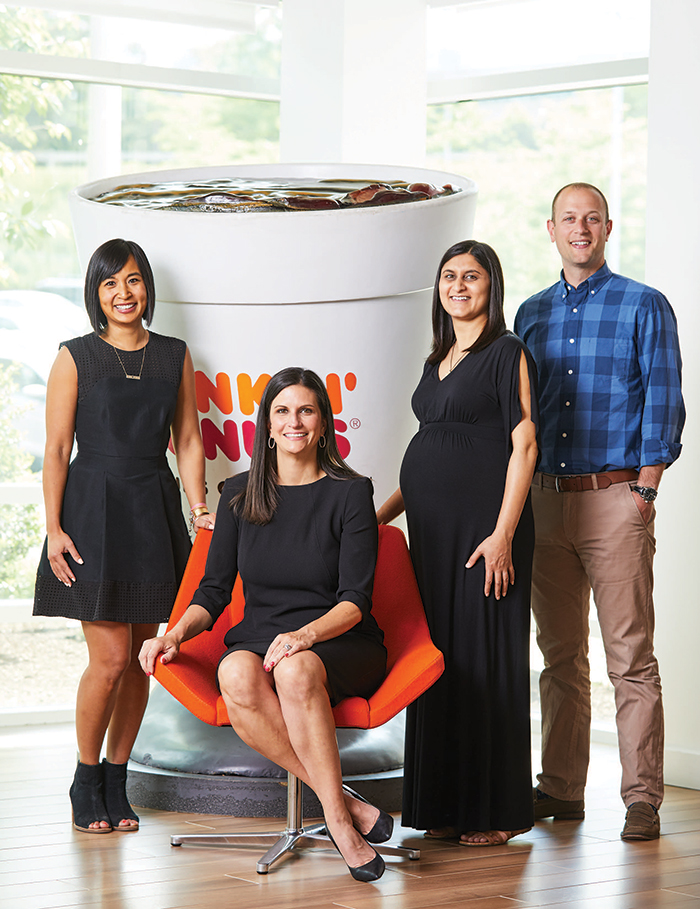
Photo: Pat Piasecki
From left, Anh-Dao Kefor ’05, Kate Jaspon ’98, Nisha Munshi, MBA’15, and Justin Unger ’08 all work in the Canton, Massachusetts, headquarters of Dunkin’ Brands.
When she began at Dunkin’, Munshi spent much of her time in a regulatory compliance role, compiling information about ingredients to create Nutrition Facts labels, as well as ingredient lists and allergen information for each Dunkin’ product. “Over the years my responsibilities have broadened to strategy, and I’m now developing nutrition-related goals and initiatives for the company as a whole,” she says.
Munshi earned her Babson MBA in part to hone her strategy skills. She also conducts trend research to track better-for-you choices at other quick-service restaurants, monitoring such information as the sugar and calorie content of their products. She shares this information with the innovation teams at Dunkin’. The company already offers options such as oatmeal and wraps with egg whites and veggies, developed in response to customer requests. “We’re always going to have those indulgent products, but consumers are becoming more savvy about what’s in their food, where it comes from, and what’s good for them,” Munshi says, adding that customers should watch for additional options coming soon. Dunkin’ Brands also removed all artificial dyes from its doughnuts and has pledged to remove them from the rest of its menu by the end of this year.
As director of strategic partnerships, Justin Unger also is responsible for reaching new customers, which his team does by linking Dunkin’ Donuts with other brands. They led a recent collaboration with Massachusetts-based shoe company Saucony, which created a Dunkin’-themed running shoe for the Boston Marathon. The shoe designers began with an existing Saucony shoe, the Kinvara 9, and tricked it out with Dunkin’ colors, images of coffee beans and a frosted doughnut, and the America Runs on Dunkin’ logo. The limited edition shoe sold out quickly, Unger says, but the benefits of such partnerships linger. “We wouldn’t necessarily be able to talk to runners the way we did, but the partnership with Saucony made our brand top of mind for new audiences,” Unger explains. “And the beauty of the partnership is that it goes both ways. We are a trusted voice for our audience, so it increases reach for both partners.”
Technology innovations also are key to maintaining and attracting customers. When Unger joined Dunkin’ Brands in 2016, he oversaw its DD Perks loyalty program and mobile app, which rewards customers with personalized promotions and offers. Customers also can use the app to place orders and pay in advance of pickup.
Dunkin’ is not alone in these types of innovations. For example, Starbucks offers a similar app. “We’ll continue to see the industry as a whole lean in on loyalty and innovation and technology and to think about how we can use them to enhance the guest experience,” Unger says. Jaspon notes a recent example of originality: “Our newest store in Quincy, Mass., is the first store in the restaurant industry that we’re aware of where you can order ahead of time, skip the drive-thru line, and go to a separate window to pick up your product.”
In the end, though, a friendly “good morning” still goes a long way in building customer loyalty, notes franchisee Goldman, who says 95 percent of the people in his stores are repeat customers. Blum agrees. “We want people to leave a little happier than when they walked in,” he says. “If we succeed, they come back the next day.”
Erin O’Donnell is a writer in Milwaukee.
]]>A few years ago, Abby Speicher Carroll, MBA’15, was set to present at a business plan competition. Her business, DARTdrones, was a flight school for people learning to pilot drones, those increasingly common flying machines buzzing and soaring about the skies.
At the time of the competition, the company wasn’t much more than a concept and neither Carroll nor her team actually knew how to operate a drone. Regardless, they decided on a whim to order one so they could demonstrate how it flies as part of their presentation.
When the new drone arrived, however, it came with no instructions, or at least, no directions in English. The hour Carroll spent practicing how to fly it proved, in hindsight, to be comically inadequate. During the competition, as the drone lifted into the air, the judges watched eagerly. “They thought I had everything under control,” Carroll says.
That wasn’t exactly true. “It went the opposite way from what I expected,” she says. “It was flying right above the judges. They were scrambling to get away.” Her father, Chris Speicher, who also is a co-founder, tried to grab the drone out of the air. Eventually, it crash landed in front of Carroll, bringing the demonstration to an unceremonious end. “Everybody thought it was hilarious, but I literally still have nightmares about it,” says Carroll.
The entrepreneurial journey is often not a smooth ride, and a hard landing or two is to be expected. Building DARTdrones since that shaky flight, Carroll has experienced uncertainty, stress, and many long hours. But she understands that the startup process is an untidy, exhilarating mess, and she has come to thrive on it. “I love chaos. I love flux. If it’s not in flux, I make it in flux,” she says. “With any company, there are endless problems. This is how business is. You have to deal with it.”
Not that she has experienced only problems. There also have been triumphs, including an appearance on the TV show Shark Tank, and she relishes that DARTdrones is a family affair, with both her father and husband on board. Today, the venture offers training in 40 cities across the U.S., with instructors who have military and commercial flying expertise, and organizations are turning to DARTdrones to understand a technology that’s poised to become a ubiquitous part of our future.
On the Hunt
For years, drones were the purview of the military. Any civilian use seemed limited to hobbyists fooling around with drones in a park. That’s changing. Earlier this year, the Federal Aviation Administration announced that more than 1 million drones had been registered with the agency. Drones have been used to watch whales and document volcanic eruptions, to survey flood damage and find survivors after natural disasters, to check insurance claims and inspect power lines. UPS is testing delivery trucks outfitted with drones, and images taken by drones are common in movies and news broadcasts.
“There are endless possibilities,” says Colin Romberger, chief pilot and operations consultant at DARTdrones. “At this point, it is a wide-open canvas.” DARTdrones is well-suited to help companies figure out these many capabilities, but keeping up with the evolving industry and its steady changes in technology and regulation isn’t easy. Mike McCann, enterprise account manager at DARTdrones, gives credit to the forward-thinking Carroll. “She has got to be a year ahead, knowing what’s coming,” McCann says. “She is really on top of things. Abby amazes me.”
Carroll developed the concept for DARTdrones during her first year at Babson. She had come to the College determined to pursue an entrepreneurial venture—she just needed to figure out what that would be. It was a busy time. She had to contend with schoolwork, a graduate assistantship, and, to make ends meet, four babysitting gigs. True to her affinity for chaos, she also adopted a dog.
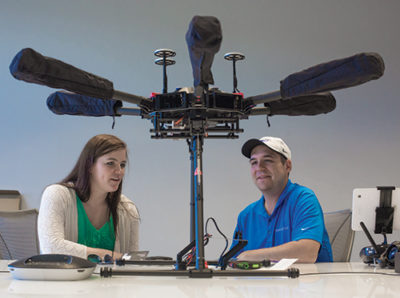
Abby Speicher Carroll and Colin Romberger, chief pilot and operations consultant at DARTdrones, examine a drone from a client.
Her studio apartment in Newton, Massachusetts, which she shared with future husband Mike Carroll, was crammed with paraphernalia, including a prototype for a baby pacifier designed to stayed attached to an infant’s face, equipment and ingredients for making mead and starting a meadery, and a snowboard training device about the size of a table. In all, she was pondering about 20 business ideas. “I was on the hunt,” she says. “I get excited about opportunities, and I can’t resist them.”
Carroll’s intensity isn’t surprising. Growing up in Dunmore, Pennsylvania, a small town near Scranton in the northeastern part of the state, she comes from a family of entrepreneurs. Her grandfather began a food brokerage when he was laid off from the A&P grocery chain, and her grandmother was district sales manager for Avon, supervising some 200 entrepreneurial women selling beauty products. Through the years, Carroll’s father has played various roles in about 30 startups and is now an entrepreneurship professor.
Whether in the classroom or in the many sports she played, Carroll had tenacity as a child, says her father. “She was always persistent,” Speicher says. “She always had that drive.” At 17, Carroll started her first business, a social enterprise that sold purses handmade by women in Ghana. She was inspired to launch the venture after accompanying her father on a trip to the country, and a portion of the profits went to fund children’s education there. For five years, Carroll worked on the business before finally deciding to move on, passing it along to a family friend to run, and the venture is still in operation today.
Carroll’s father also had a hand in the start of DARTdrones. As she debated what type of business to start at Babson, Speicher nudged her toward drones. Growing excited about the aircraft’s commercial potential, Speicher was fascinated when Amazon’s Jeff Bezos went on 60 Minutes in 2013 and demonstrated how a drone could deliver a package. “This is coming on,” Speicher would tell Carroll. “This is going to take over.” In time, she came to agree that drones could be a great business. But shaping and growing that business would be a long, trying process.
Frustration and Inspiration
Carroll began working on DARTdrones in early 2014. Soon enough, doubts followed.
As many entrepreneurs do when launching a business, Carroll first focused on market research. She identified potential competitors and customers, but the work felt unproductive. “Everything was so theoretical,” she says. “I would call people, asking, ‘What are your feelings toward drones?’” The months slipped by. No customers were in sight. By the fall, her classmates were looking ahead to graduation and applying for jobs, but Carroll was tethered to a far-from-solid business concept. “I was nervous,” she says. “DARTdrones was just fluttering around. I can see why people quit at that point.”
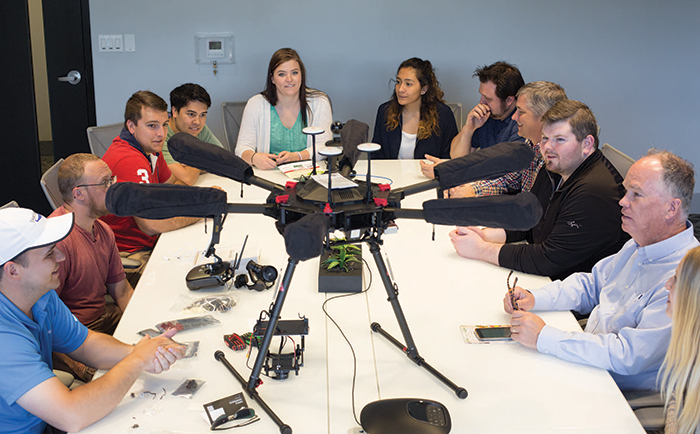
Abby Speicher Carroll and the staff at the DARTdrones office in Jessup, Pennsylvania, gather for a meeting.
Carroll decided to give herself till the winter break to decide whether to continue the business. But then her dad began pressing her with another idea. Why not sell drones, he proposed. The holiday season was coming, and a family friend was willing to invest $50,000. They could order a shipment of drones and then resell them. Drones promised to be a hot holiday gift.
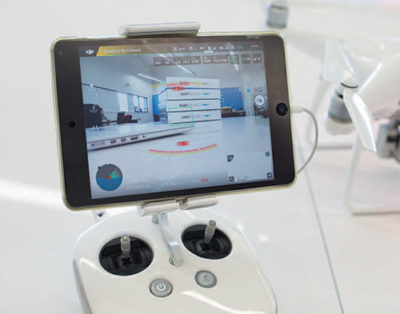
A controller for piloting a drone comes with a video screen that displays the aircraft’s surroundings.
While DARTdrones was envisioned originally as more of an all-encompassing company, one that would sell drones as well as offer instructional support, Carroll had long since decided that a focus on training was the way to go, particularly after her scary flight at the business competition demonstrated the need for such courses. Despite misgivings, she went along with her father’s idea. The hope was that their shipment of drones would come in by Black Friday, which would leave plenty of time to resell them.
That seemingly solid plan went awry, however, as the drones didn’t arrive until after Christmas. “We were stuck with all these drones,” says Carroll. “It was horrible.” Though she was able to sell some in the ensuing weeks, she admits that a bunch of unsold drones, their technology now outdated, are sitting in her parents’ home.
After that fiasco, Carroll was filled with frustration. But she soon had a flash of inspiration that would turn the business around. As someone who follows the industry, she saw that DJI, a leading drone manufacturer, was offering free demos. Carroll had a thought: What if DARTdrones piggybacked on the demos to attract customers? Partnering with DJI, DARTdrones began hosting events throughout the Northeast, presenting DJI’s two-hour demo and then offering a free DARTdrones training session. DARTdrones was able to interact with customers, receive feedback on its course, and spread the word about the company.
Sales took off, and, suddenly, the uncertainty of 2014 gave way to excitement in 2015. In the spring, DARTdrones won Babson’s prestigious BETA competition, and after Carroll’s May graduation, she participated in the College’s Summer Venture Program. Carroll gives much credit to Babson for helping her grow DARTdrones. The College left her with a network of friends to turn to for business advice, and it gave her confidence to know that, whatever issue she faces, there’s probably a case study from her Babson days that covers it. “I couldn’t have made it this far without Babson,” says Carroll, who also took part in the College’s Women Innovating Now Lab. “I’m like the Babson billboard. It was the perfect place for me.”
DARTdrones made a push for expansion through the rest of 2015, thanks in part to a rash comment by Carroll. While talking casually with the owner of DroneLife, an influential industry website, Carroll was told that the site couldn’t cover DARTdrones until it was a national company. “We have plans to go national,” Carroll responded. “By the end of this year, we’ll be national.” At the time, though, DARTdrones actually had no such plans, so Carroll’s mind raced. “I go home. I was like, we have to go national. What’s the plan?”

Abby Speicher Carroll talks with her dad and co-founder, Chris Speicher, an entrepreneurship professor at Marywood University.
A big obstacle to growth was finding enough qualified pilots to teach courses. Eventually, the company was able to recruit 13 pilots of commercial and military aircraft who had an interest in drone technology. The pilots were invited to a multiday train-the-trainer session, though the session’s location concerned Carroll. Because DARTdrones had no money to rent a training space, it had to make do with her parents’ house, with classes held inside and pilots practicing flying on the lawn. Carroll served the pilots mac and cheese and removed all pictures of herself to try to make the house look more professional. In the end, the pilots were trained and had a good time, and the company was on its way to going national.
Since then DARTdrones has continued to recruit instructors and today has about 35. Aviation is a male-dominated world, and as a young woman CEO, Carroll has encountered self-centered pilots who are dismissive of her. She doesn’t put up with them. “I have been deliberate about who joins the company,” Carroll says. “I have denied instructors who don’t seem like they could handle me being in charge.”
Then the Call Came
DARTdrones was on an upswing by the end of 2015, but the unpredictable entrepreneurial journey brought new challenges in 2016, with Carroll facing what she calls a “dark time.” A painful company shake-up, which she declines to talk about, was part of the reason. Beyond that, the long days spent building a venture were finally catching up to her. In a typical week, she worked 80 hours. “It wasn’t sustainable,” she says. “I was really burned out.”
To recharge, she went on a 10-day cruise with her parents and younger brother. The respite worked, and Carroll brought a new mindset back to DARTdrones. She vowed not to work as much, and away from the office, especially on weekends, she made a conscious effort to think less about the business. Not that she completely ditched her full, frenetic life. “She is not one to sit still,” says husband Mike Carroll, whom she married in 2017. For a time she took up painting, and then she and her husband remodeled a house, which meant hours of sanding, painting, and laying floors. Still, a change was noticeable. “The first year or two, every second of the day was DARTdrones,” says her husband. “She now has a different perspective.”
As the dark time subsided, Carroll got a call with major business implications. The previous year, she had applied to be on Shark Tank. Now the TV show called to say her application had been accepted. She would be pitching DARTdrones to the Sharks, the show’s panel of investors.
Carroll’s episode was taped in June 2016. “It was stressful leading up to it,” she says. “You’re worried, ‘What if I totally bomb?’” Thankfully, the taping went well, but afterward, she felt renewed stress. The exposure promised to boost DARTdrones’ business, but the network gave Carroll no indication of when her episode would air. So the company rushed to be ready, redoing its website and adding classes and instructors, while Carroll constantly checked the upcoming TV schedule.
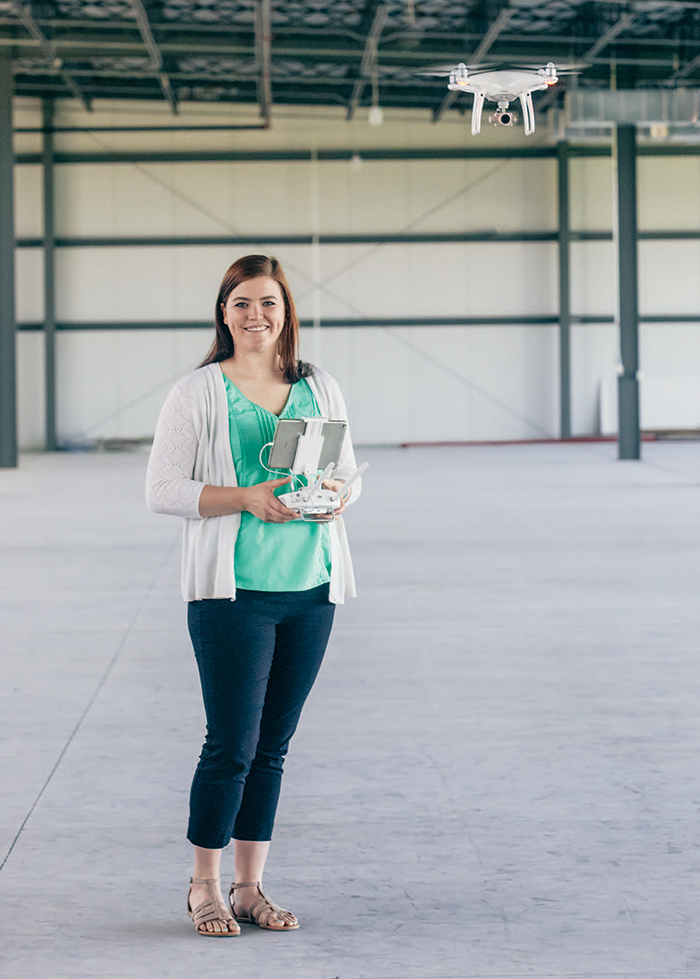
DARTdrones is located within a business center that supports and encourages startups. This large, unoccupied space, which is down the hall from DARTdrones, is slated for future businesses.
Ultimately, the episode didn’t air until February 2017. The night it premiered, Carroll’s parents threw a big party, their house packed with family, friends, and DARTdrones employees. Everyone marveled at Carroll’s poise on the screen, and once the show was over, they all cheered.
After the episode aired, DARTdrones experienced a surge in business. What the company didn’t receive from Shark Tank, however, was a deal. At the taping, Carroll had agreed to give Mark Cuban a 10 percent stake for $300,000, but once the paperwork came to make the deal official, Carroll had second thoughts. She couldn’t see herself giving up any control in the venture she had worked so hard to create. “Having someone in charge of me wasn’t going to work,” she says. “I can’t have a boss. I got into this to be my own boss.” In the end, the paperwork was left unsigned.
Today, thriving DARTdrones offers 40 classes a month across the U.S., and more than 8,000 students have taken its courses. Police and fire departments are big customers, with more than 100 having gone through DARTdrones programs. Although regulations keep some companies cautious about using drones, others are eager to embrace the aircraft’s potential, and so DARTdrones has been tailoring more programs to corporate clients, says Carroll.
Though DARTdrones has an office in Jessup, Pennsylvania, only a short drive from Carroll’s hometown of Dunmore, she and her husband make their home nowadays in Park City, Utah, near the company’s Salt Lake City office. The pair fell in love with the area while attending Salt Lake’s Westminster College, where they met.
Carroll’s husband joined the company in 2016 and serves as director of accounting. Initially, Carroll was nervous about blending her personal and professional lives. “After the first month, I thought it was the best thing,” she says. “It is really nice. We are never apart.” The two bring different strengths to the office, which helps them avoid stepping on each other’s toes. The creative Abby focuses on marketing and strategy, while numbers and logistics are the domain of analytical Mike.
Outside the office, Carroll keeps up her busy lifestyle. She hikes, camps, and snowboards. She also flies to Pennsylvania to visit family and check on the Jessup office. That office sits on a ridge overlooking a valley full of houses, highways, and communities. Standing there, Carroll looks out on a world she has known her entire life.
Despite all the ups and downs, Carroll remains passionate about entrepreneurship. “I hope I am a serial entrepreneur,” she says. “I hope I’ll use this experience for the next business I start.”
]]>But while such a prospect concerns her, she believes that facts, not polemics, will ultimately win the day. “People have to come to these conclusions on their own. I tell my students, ‘I’m giving you the data. You can make your own decisions,’” she says.
From a young age, nature was a passion for Carey. As a child, living outside Rochester, N.Y., she was always drawn to water. “I grew up in the Great Lakes area, and my family sailed. I was skipper of my own sailboat by the time I was 8,” she says.
The future biogeochemist also had an intuitive, almost prescient grasp of her someday career. “When I was 4 or 5, I remember sitting in the back of my mom’s car and seeing pavement being laid somewhere. And I said, ‘Mom, they’re suffocating the earth,’” she recalls. “Now I study soil respiration. I study how soils breathe—how oxygen is taken up by microbes, and how soil microbes release carbon dioxide.”
Carey earned her B.S. in environmental policy and planning at Virginia Tech. She intended to pursue a career in low-impact development, which involves creating systems for runoff that mimic the natural processes of water flow, protecting water quality and aquatic habitats. “And as I studied that,” Carey says, “I started getting more interested in the science and the biogeochemistry behind water quality.” She went straight from college into a master’s degree program in environmental science at Yale’s School of Forestry & Environmental Studies.
She envisioned herself one day running an environmentally focused nonprofit, but at some point, the allure of field work and research took over. She worked for a professor who sent her out to collect samples of river water, and that led Carey to pursue classes in hydrology. Not everyone dreams of standing hip deep in a cold river, filtering water samples, but for Carey, the work was a fit. “I love to push myself physically, and it was fun,” she says, cheerfully recalling a day so cold her samples froze in the syringe.
After Yale, she took a job with the Massachusetts Department of Fish and Game, doing river restoration. “We really responded to constituent concerns,” she says, fielding calls about streams running dry or fish populations disappearing. Carey and her colleagues would investigate the causes behind the concerns. “My knowledge of river hydrology and rivers was solidified there,” she says. “It was a perfect job.”
Carey was on a bus headed to New York, reading a paper about stream flow in a peer-reviewed journal, when she had the thought, “I want to write a paper like this; I want to do this level of science.” Knowing such work would require a Ph.D., she returned to school—this time to Boston University—and earned a doctorate in earth science. Later, she held postdoc positions with the EPA in Rhode Island and at the Marine Biological Laboratory in Woods Hole on Cape Cod before joining the Babson faculty full time in January 2017.
Much of Carey’s research focuses on silicon, an abundant element found on land and in water; she looks at how human activities are altering the amount of silicon that reaches the ocean, which in turn impacts microscopic ocean plants and carbon dioxide levels. In some cases, human activity has decreased levels of silicon, and in others it has increased those levels. Both have significance. “When we’re modeling future climate scenarios, it’s really important to understand the drivers of carbon dioxide, because they’re shifting,” says Carey. It’s serious science that has sent her to Alaska several times to study the mechanisms driving silicon export and the ways in which human activities and climate change alter the flux of silicon to oceans.
Working at Babson might seem a curious choice for someone with Carey’s interests. But she says taking the job was “a no-brainer.” “I love the environment here. My colleagues are so friendly, and while we are dedicated researchers, I like how our focus is also on the students’ Babson experience, rather than solely on our own research endeavors,” she says. “The students are very smart. They ask good questions. And I knew that if I was going to be teaching at a small school, I wanted to teach at a good school.”
In the course she teaches, “Oceanography,” Carey covers the physical, biological, and chemical processes at work in our oceans. While the objective of the course is to impart a basic scientific understanding of these processes, she also addresses such topics as pollution, fisheries management, and renewable energy.
Carey believes that teaching future business leaders might have an even greater impact than teaching future environmentalists who have already, as she puts it, “drunk the Kool-Aid.” “I try to take students out of their business bubble and make them amazed at the natural world. I feel like there’s an avenue for them doing positive things related to the ocean, as entrepreneurs. There are problems the market could maybe fix,” she says. If her students don’t specifically pursue environmental entrepreneurship, she hopes they’ll at least consider their own environmental impact and how natural systems work. “I try to foster their curiosity,” she says.
And she lets the facts speak for themselves. “When I teach climate change, we look at CO2 levels over time,” she says. “We look at a graph showing where we are now and what’s happened over the last 800,000 years. And that graph is just—well, I don’t need to say anything more.”
]]>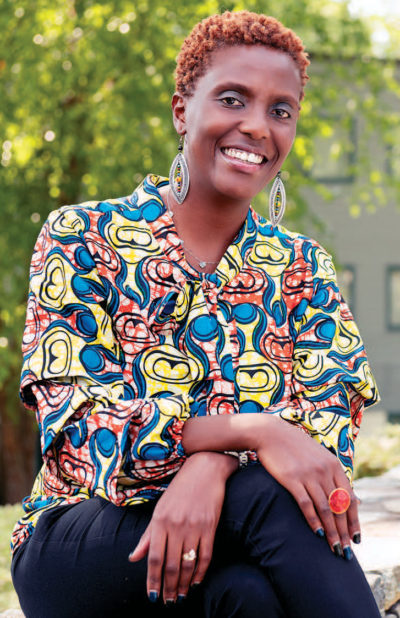
Photo: Webb Chappell
Waceke Nduati has been a participant and an instructor in the “Launch and Grow” program.
“At Babson, I had an ‘aha moment,’” Waceke says. “Women carry a lot of ‘we’re not good enough,’ no matter what fantastic things we’ve done. But I realized, ‘My goodness, I am enough.’ You leave Babson knowing you are enough.”
And that is more or less the point of the program, says Susan Duffy, executive director of the Center for Women’s Entrepreneurial Leadership, who co-leads the program with Mary Gale, senior lecturer of entrepreneurship. “A lot of what we’re doing,” says Duffy, “is opening thinking around how big and bold you can be, to really change expectations around what kind of impact you can have.”
Participants have represented a range of industries, from sports to fashion to marketing to food. They face many of the same challenges that entrepreneurs often confront, but, as women and Kenyans, they encounter other obstacles as well. For example, Waceke explains, “Historically, women have not been inheritors of property and do not have the traditional security that banks want.” Hence, just obtaining a loan can be difficult.
The program offers concrete skill building, with classes on pitching, operations, and finance. But what Duffy describes as “Babson’s special sauce” is the ability to create an environment that promotes what she calls “self-efficacy.” The women test and try ideas, learn from not just the faculty but their cohort, share stories, help ease one another’s anxieties, and act as champions for one another. “Those elements combine to create an environment where people say, ‘I’ve got this.’ That’s self-efficacy,” Duffy says. “They might come in thinking, ‘Well, I have this business,’ but they leave thinking, ‘I’m just getting started; the sky’s the limit.’”
Waceke says she joined the 2017 cohort because she wanted to be in a different environment and gain new perspectives. “I was at that stage where I was tired of hearing my own voice,” she says. The program made her realize that her organization needed a cultural shift. “I cannot be the only entrepreneur in the company,” she says. “I had to create an entrepreneurial culture. Setting up ET&A was the first thing I did when I came back.”
This year, Waceke returned to the program as an instructor, co-teaching a session with Mary Gale. Waceke was excited to help her countrywomen undergo the process she found so invaluable. “The program showed me how to think like a leader,” she says. “It is really transformational.”—Jane Dornbusch
]]>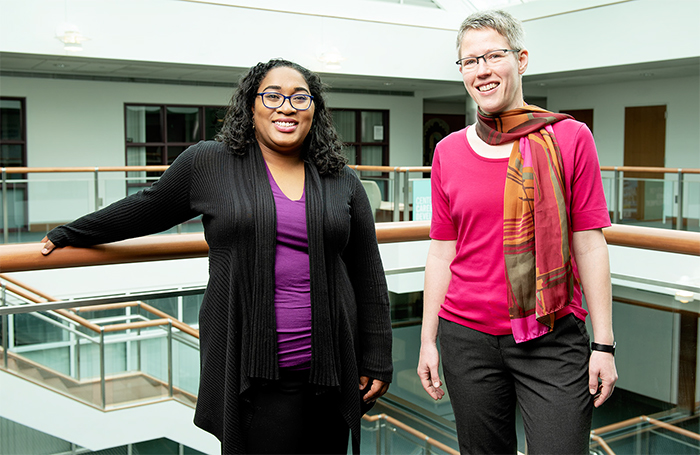
Photo: Webb Chappell
Janai Mungalsingh ’08 (left) and Katrin Fischer, MBA’15
Eager kids with open minds who are unafraid to take risks. That describes the students who typically enroll in Babson’s Summer Study for rising high school juniors and seniors, says Katrin Fischer, MBA’15, faculty director for the program and adjunct lecturer in arts and humanities.
The cohort of about 130 shares other traits. “I would say they’re naturally curious,” says Janai Mungalsingh ’08, Babson’s youth programs curriculum designer. Adds Fischer, “They have a kind of openness about the unknown, about new or unstructured experiences.”
During the four-week program, students spend mornings in the classroom; the emphasis is on Babson’s Entrepreneurial Thought & Action methodology. The course, taught by Babson faculty, covers topics ranging from business law to sustainability to presentation skills. This last one is key because, in true Babson fashion, the course builds toward a pitch of a business idea the students, working in groups, have developed. Along the way, they test their ideas, build prototypes, and receive feedback. Past student ventures have included Panana, which supports education in developing countries through sales of notebooks made from banana leaves, and Kover, a clear skin patch that allows users to sample beauty products in stores.
Afternoons are spent in activities that reinforce the morning’s lessons. These might include company site visits, networking events with local entrepreneurs, or student-run forums. Mungalsingh, who oversees this aspect of the program, notes that students often react to activities in ways that show their understanding of lessons learned in the classroom. “I get the pleasure of seeing those ‘aha moments,’” she says.
Admission to the program is competitive—the acceptance rate is around 33 percent—and students have come from about 37 countries. It might seem natural that many Summer Study participants eventually end up as Babson students, and, in fact, during the program’s eight-year history, about 10 percent of enrollees have matriculated at the College. But the program wasn’t designed to put Babson on the radar of prospective students, or vice versa. Mungalsingh says, “It was a way to create access to and share this methodology with young people everywhere.”
Participants gain valuable life skills, says Fischer. “Even if they do not go on to be entrepreneurs, we are all entrepreneurs of our own lives,” she notes. Students learn to cope with ambiguity, change, and failure.
Some students waste no time putting their skills to work. Mungalsingh recounts how, when construction limited use of the Webster Center, students—who wanted access to a gym—advocated for an arrangement with Boston Sports Clubs and negotiated a rate for the program. “And it was a great rate,” she says.
Students invariably offer enthusiastic feedback about the program, says Mungalsingh, who is equally ardent about her work with the students. “It’s energizing to see their passion, their dedication, their excitement,” she says.
But Mungalsingh is particularly pleased at the comments she hears from parents. “They call me and say, ‘What did you do to my child?’” she says. “‘They’re thinking for themselves, they’re doing their own thing, and they didn’t even ask me for help.’”—Jane Dornbusch
Applications for 2019 Summer Study are now open. The application closes March 1. Apply now »
]]>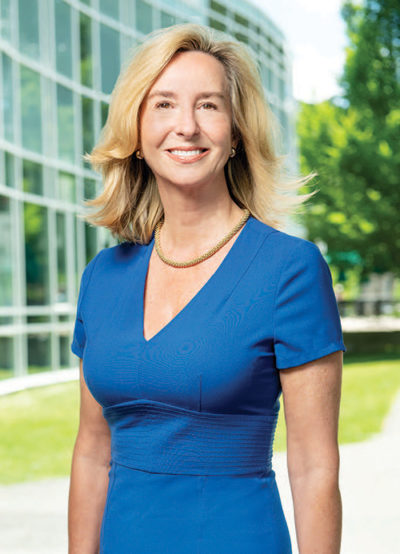
Photo: Webb Chappell
Babson President Kerry Healey
The weekend featured an impressive collection of speakers, panelists, and international business leaders, facilitating thoughtful discussions and a lively exchange of ideas about the future of global enterprise and entrepreneurship. This year, we also were joined by 27 student ambassadors, including several of our incredible Global Scholars, who inspired us with their vision and ambition to create economic and social value everywhere.
One of the highlights of this year’s conference was the official launch of Babson’s Institute for Family Entrepreneurship, a new hub of teaching, research, and innovative programs dedicated to advancing entrepreneurial families around the world. An estimated 70 to 90 percent of annual global GDP is created by family businesses, according to the Family Firm Institute, and studies show that family businesses tend to be more socially responsible and focused on the triple bottom line of people, planet, and profits. The multigenerational survival of family enterprises is critical to global job creation, prosperity, and positive social impact.
When Babson was founded nearly 100 years ago, its primary focus was to educate the sons of businessmen—in 1919, Babson was all male—and prepare them to take over their family businesses. Since then, Babson has remained at the forefront of educating entrepreneurial families and conducting research and programming to help them achieve continued growth. Today, half of Babson’s students come from entrepreneurial families, and as we approach our Centennial, supporting family enterprises remains a key priority.
BCW also provided an opportunity to introduce Lauri Union, the Institute for Family Entrepreneurship’s new executive director, to the Babson community. Lauri has a long history of supporting entrepreneurial families and is known for the turnaround and sale of her family business after becoming its president and CEO when she was just 27. Under her direction, the Institute will continue Babson’s role as an innovator and leader for family entrepreneurship (for more, see Entrepreneurship Through the Generations).
During the past four years, BCW has grown and evolved into the world’s foremost gathering of entrepreneurial thinkers. I am excited to share that next year, as part of Babson’s Centennial celebrations, BCW will come home to Babson with events in and around Boston’s innovation ecosystem.
After a wonderful BCW experience (to see photos from Madrid, go to Connections), I’m happy to be back in Wellesley, enjoying a beautiful New England summer and preparing to welcome the Class of 2022 to campus this fall. I hope you have enjoyed a relaxing summer with family and friends, and I look forward to seeing you at Back to Babson in September.

Kerry Healey
]]>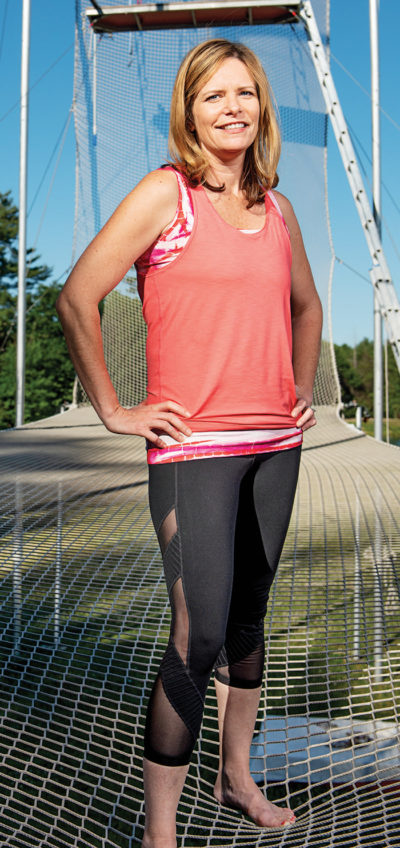
Photo: Webb Chappell
Lauren Belmont, associate director of Academic Technologies
What was your first job? I worked for The Home Depot’s corporate office near Atlanta. They wanted young, creative people to help them design training courses for store employees. I’d put on an apron and work alongside associates who had been there for 20 years and knew every single type of drill bit, fastener, and saw, and I learned extensively about the products myself so that I could design the training.
How did you come North? It was the dot-com boom, and I had a surprising number of job offers from all over. But one was from the Boston area, where my brother was living at the time. He said it’s a great place for young people in technology, and the company paid for my relocation.
When did you come to Babson? In 2005. I was married, and we wanted to start a family—I have three girls—but the company I was working for was small and didn’t have any maternity leave. I talked with HR, and they were nice but not open to any flexibility in my schedule. Babson has been really flexible with me in terms of work-life balance. They made it work in a way that I feel a lot of companies don’t for women.
What are your job responsibilities? I still do some course design and content development, but I’m probably more focused right now on curriculum and production, just because there are so many programs that we’re involved with. I also focus a lot on faculty training, which I love.
What are your hobbies? I’m definitely one of those people who has my Kindle with me all the time. I love historical fiction, particularly anything about World War II or the Civil War. And I’m sort of a thrill-seeker at heart, so you can often find me at Revolution Trapeze in Stow. I started to do flying trapeze a few years ago. It seemed like a good adrenaline rush—and it really is.—Donna Coco
]]>As part of its restoration, the Globe eventually will be relocated to a more significant position on campus: Centennial Park, which is currently under construction. The park and restoration project are being funded by the generosity of trustee Robert Weissman ’64, H’94, P’87, ’90, and his wife, Jan, P’87, ’90. Centennial Park will be on College Drive, across from Hollister Hall and the Reynolds Campus Center, and the Globe, along with flags that represent the 80-plus countries with ties to Babson, will serve as its centerpiece.
President Kerry Healey had a vision for bringing these two symbols of Babson’s global presence and diversity into one central location, says David Grissino, director of capital projects and planning at Babson. “This will put the Globe in a much more prominent place on campus, so it becomes part of everyday life for students, visitors, faculty, and staff,” he says.
Founder Roger Babson commissioned the Globe in 1947 to stimulate interest in the world among students and visitors. Dedicated in 1955, it was positioned next to Coleman Hall to create what was then known as The Map and Globe Museum, with Coleman housing a 65-foot plaster relief map of the contiguous 48 states (removed in 1998). The intention was to enclose the Globe to protect its structure and mechanics, but this never came to pass. Nonetheless, the Globe, which used to spin and rotate, drew thousands of visitors to campus. Exposed to weather, however, it eventually began to degrade. By the 1980s, the Globe had rusted and failed. Although restored in the early 1990s, it has since deteriorated again.
Babson’s pending Centennial and the multiple construction projects transforming campus spurred the idea for Centennial Park, says Grissino, who adds that before the Globe can be restored fully, it must be moved to its new location. The Globe has two main components, he explains: the physical structure of the globe, and the mechanics that sit underneath it in a bunker. Ideally, during next winter the bunker will be constructed and the mechanics restored, and then the Globe will be put in place. Next would come restoring the Globe’s surface, during which the project would be enclosed to create a temperature-controlled environment.
Plans include making the Globe spin again and improving on its original design to allow for exposure to the elements. “In the last restoration, a vinyl sheet was applied to the surface of the Globe, and the ravages of time and solar exposure caused it to fade,” Grissino says. “So we’re working with a company that specializes in exterior painting. If we paint directly on the Globe, it gives us a lot more flexibility to do repairs. We wouldn’t be in a repeated maintenance cycle, which would be costly and disruptive.”
If all goes according to plan, the Globe and Centennial Park, which also will include a life-size bronze statue of Roger Babson and markers celebrating the College’s 100-year history, will be ready for visitors next spring. Meeting this goal means overcoming huge challenges and tight deadlines, but the team behind Centennial Park is not daunted. “The Globe is a unique object, and this is also a unique time in the school’s history. It’s meaningful to a lot of people that we’re part of a trajectory here as the campus celebrates,” Grissino says. He adds: “We’re moving the world.”—Donna Coco
]]>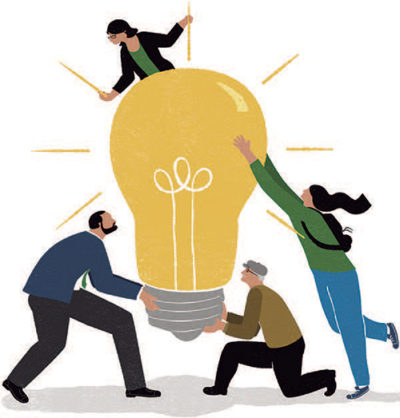
Illustration: Martin Elfman
To help guide these families in their endeavors, the IFE is introducing the Family Entrepreneurship Amplifier program this fall. “When you think about amplifying entrepreneurship as it passes from generation to generation, there can be gaps and missed opportunities,” says Union, who successfully managed the turnaround and sale of her own family’s business, Union Corrugating. “Our students often are coming in with a really different perspective from their parents, and their Babson experience is leading them to think about entrepreneurship and themselves in a very different way. When they return to the family business, there can be a gap between the child who left and the person who comes back.”
To close that gap, the program engages students and their families together in coursework focused on family business and entrepreneurship throughout the students’ four years at Babson. Each year, students who are accepted into the program will earn four credits (two for each semester). At least one leader from the family business also will take part. “The family has to want to be involved,” Union says, “by speaking with their child on a regular basis and by being on campus at least once during the year.”
Plans for the course include first asking students to investigate and develop a perspective on the past, present, and future state of their family’s entrepreneurship practice in relation to the business, the family, and the student’s personal goals. Coursework will include interviewing family members and nonrelated employees. “It’s hard to build on something if you don’t know what it is to start or what its value is,” Union says. “This also helps students transition from being a child to talking with managers in the business.”
Parents also need to learn how to work with their children, notes Union. “It’s a little bit of a shift in the relationship, seeing the child as a businessperson,” she says. “The entrepreneurial vision that the older generation has may be different from the student’s. So there’s an opportunity to align those visions. Then the family can best leverage the talents and aspirations of everyone.”
Currently, the program is in a design and test phase, so the initial cohort will include 10 students from a mix of class years, and participants will be asked for feedback. Going forward, there will be grade-specific cohorts, one for each class year, with 40 students eventually involved. Because the cohorts will move through their years together, says Union, they can learn from one another, both students and families. “The best outcome will be for cohorts to develop trusting relationships where they can talk openly with each other,” she says, “and, ideally, carry those relationships out of Babson.”—Donna Coco
To learn more about the Institute for Family Entrepreneurship, visit www.babson.edu/ife.
]]>From the wheel of his Ford pickup, which pulls his 33-foot-long RV trailer, Holland has driven many a mile. As rest stops, billboards, and exit signs blur by, his eyes may watch the road, but his mind roams elsewhere. “I’m trapped for hours with my thoughts,” he says. “You can’t escape them, but in a way, that’s good. Your mind can dwell on problems. You start thinking, how can I fix this? I’ve had breakthroughs with self-conversations.”
Holland is the founder and executive chairman of Storyblocks, a subscription service based in Arlington, Virginia, that provides stock images, audio, and video. Holland started the company the year before he enrolled at Babson, a kid chasing a dream in his parents’ house. Since then, it has grown into a successful enterprise with 100 employees and a digital library of 10 million files that subscribers can peruse. In 2017, the company earned $32 million in revenue.
That entrepreneurial journey was enthralling and rewarding, but it also overwhelmed Holland at times, leaving him feeling unsettled and burned out. “I was so immersed. I needed to come up for air,” he says. “I had a desire to get up and run.”
The RV, with its promise of wanderings and adventure, proved his salvation. He bought it in 2013. Out of town for a wedding, Holland found himself with some time to kill and, on an impulse, checked out an RV dealership. He always had enjoyed road trips, and suddenly, as he talked to the salesman, the idea of owning an RV began to feel right. Two weeks later, it was his.
At first, though, Holland was a little hesitant to use it. As CEO, he was fully engrossed in running the company, so disappearing in an RV didn’t seem like a smart idea. “I was really worried that, if I wasn’t present, things would fall apart,” he says. But his colleagues supported him, told him he deserved some time away, so Holland began taking regular jaunts of a week or more in his RV. He was never completely unplugged and was almost always reachable, but nonetheless, he felt lighter. The stress of the office melted away with the miles. “When I’m traveling,” Holland says, “I don’t dwell on anxiety.”
Fast forward to 2016. Holland removed himself from the company’s day-to-day responsibilities, stepping down as Storyblocks CEO and becoming executive chairman, and took to the road full time. He traveled from coast to coast and was amazed at the country’s beauty. “If I had to summarize America in one word, it’s variety,” he says. “I can go through the lush greens of Kentucky, to Tornado Alley and the flatlands of Oklahoma, to the majestic mountains of Colorado, and then end up in Malibu for drinks on the beach.”
Before taking to his RV, Holland hadn’t traveled to the heart of the country, to all those states that he and so many of us simply fly over on the way to somewhere else. Now he explores every nook and cranny of the U.S. and makes the effort to reach out and talk to people, whether coal miners in West Virginia or tailgaters at a NASCAR race in North Carolina. “I’ve met people from all walks of life,” he says.
Holland’s companion for many of these adventures has been his then-girlfriend, now wife, Mary Ashley, whom he married last year. Holland took it as a good sign that they got along so well even after spending months together traveling. “We were in close quarters, and we didn’t want to kill each other,” he says. Still, a few months ago, Mary Ashley decided to return to the couple’s often vacant home in Vail, Colorado, and resume working as a veterinarian. Around that time, Holland began to feel something he hadn’t felt in a while: the entrepreneurial itch. Yes, travel was wonderful, but after two years on the road, he missed the everyday fulfillment of working and business. “It hit me like a bag of bricks,” he says. “I got to do something.”
Holland had an idea. Having visited the 48 contiguous states in his RV, driving about 50,000 miles along the way, he saw that many RV parks are congested and unappealing. He then thought about how the country is full of farms and wineries. What if a company existed that could help RV owners find places like that to park their vehicles for the night?
Holland contemplated starting such a company but then discovered one already existed: Harvest Hosts. He contacted the owners, who had been running the venture for nine years, and asked if they were up for selling. After some negotiations, Holland bought Harvest Hosts in May and now runs a company that aligns perfectly with his love of RVs and traveling.
An annual membership at Harvest Hosts allows RV owners to stay for free at a network of more than 600 farms, vineyards, museums, and attractions, and Holland is hoping to sign up hundreds more locations. While he holed up in Vail for part of the summer, he remains on the road more often than not these days, with his wife often flying out to meet him. His RV has a cozy workstation, and his days have a predictable rhythm, with Holland taking business calls at 9 and 10 a.m. before hitting the highway.
For Holland, the road remains his office, his home away from home, his inspiration. “I find it hard to ease back on traveling,” he says. Perhaps one day he and Mary Ashley will have children, but he doesn’t think even that will curtail his wanderlust. “I know a lot of parents who take their kids with them,” he says. “You can throw your kids in the RV and have total flexibility.”
Traveling with Kindness
Leon Logothetis’ life is a series of adventures. And those adventures have put him in some daunting situations. Earlier this year, for instance, Logothetis ’99 embarked on a trek from Alaska to Argentina in a 50-year-old yellow Volkswagen Beetle. “I arrived in Alaska, it’s minus 30, and I’m in a car that doesn’t have any heating,” he says. In that instant, one thought blared in his head: “You’ve gone insane.”
To understand how Logothetis arrived at that moment, however, involves going back to 2005, when he was living in London and working as a stockbroker. From the outside, his life seemed like a success, but Logothetis was uninspired and unhappy, living what felt like some other person’s idea of the perfect existence. “It wasn’t me,” he says. “I reached a point where I was in a terrible place. The pain was so much, the feeling that I was wasting my life.”
Watching The Motorcycle Diaries, a romantic road movie about guerrilla leader Che Guevara’s travels as a young man, Logothetis grew inspired. “It touched me. I always felt this urge to go on an adventure,” he says. “I wasn’t built to sit behind a desk. I was built to connect. I was built to meet the world.” Feeling like he had no other option, he quit his job and set off on a life very much beyond the typical, a decision that left those around him baffled. “They thought I was a nut job,” he says.
Since then, Logothetis has become a traveling man, visiting more than 90 countries and undertaking a slew of fantastical journeys that have become the basis for books and TV shows. In its three seasons, Amazing Adventures of a Nobody, which aired on the National Geographic channel and also led to a book by the same name, Logothetis traveled across the U.K., the U.S., and Europe on 5 pounds, 5 dollars, and 5 euros, respectively, per day. In Live, Love, Explore, which is part memoir, part self-help book, Logothetis details his adventures and the life lessons he learned from them. For his most recent project, The Kindness Diaries, which was first a book that later became a Netflix TV show, Logothetis traveled around the world on a vintage motorcycle, relying on the kindness of strangers for food, gas, and shelter.
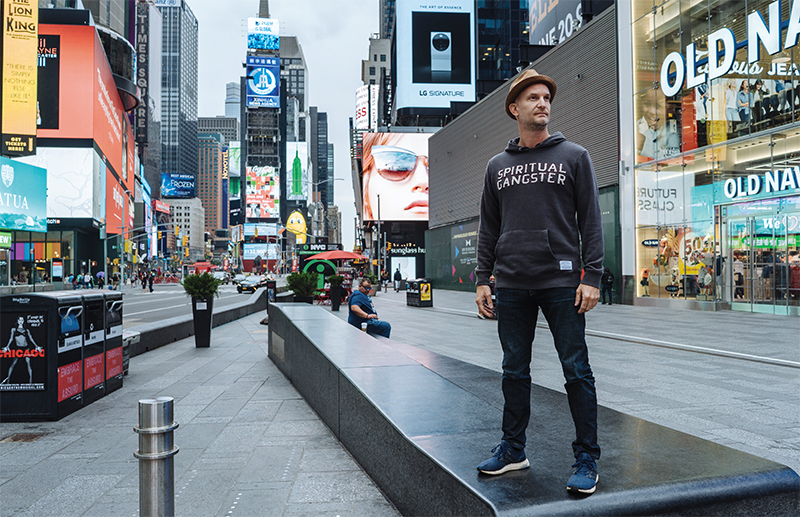
Photo: Gene Smirnov
New York’s Times Square holds special significance for adventurer Leon Logothetis ’99, who has visited more than 90 countries. He once launched a cross-country trek from there, traveling all the way to Hollywood, California, on only $5 a day.
Logothetis admits that approaching strangers and asking for help isn’t easy. Most people turn him down. But when he’s in an unfamiliar town and desperate for a place to sleep, he keeps trying. “You always find that person,” he says. “It’s about speaking to their heart.”
Whenever someone has helped him, he makes sure to return their kindness in some way. In one episode of The Kindness Diaries, Logothetis talked with a man named Tony in a Pittsburgh park. When Logothetis asked Tony if he could stay with him that night, Tony revealed that he was homeless. “My initial reaction was shame,” Logothetis says. “I’m asking to stay at his house, and he has nothing. What’s wrong with me?” But Tony offered to share some food and blankets, so Logothetis, deeply moved by the gesture, spent the night sleeping next to him on the concrete. Calling Tony one of the most generous men he has ever met, Logothetis says, “He taught me true wealth is not in our wallets. If he can be kind and he has nothing, then I have no excuses.” The next day, Logothetis offered to help find Tony housing and put him in a certificate program. Tony was left with tears in his eyes.
When Logothetis started going on adventures, he was motivated by self-preservation and the need to find fulfillment in his life. “I wanted to free myself,” he says. But as the years passed, and he encountered more people and drove mile upon mile, that motivation has changed. Now he hopes to embolden people to spread kindness and also to leave their unsatisfying jobs behind. “It’s not good enough to just travel for yourself,” he says. “My mission is to do everything in my power to inspire others to see there’s another way to live.” He has heard from thousands of people who have been touched by his travels. “I feel honored. That’s why I do this,” Logothetis says. “It makes traveling worthwhile. It makes freezing your ass in Alaska worthwhile.”
Speaking of the cold of Alaska, that’s where Logothetis started filming season two of The Kindness Diaries. His journey in that old Beetle from Alaska to Argentina, which took almost four months, was recently completed. The new season is set to premier on Netflix in December. Looking ahead, Logothetis already is planning the show’s third season, which will be a trek from South Africa to Finland, a more than 9,000-mile journey. “You never know what’s going to happen,” he says. “I look forward to the Sudanese border.”
While he’s a man at home in the world, Logothetis does rent a house in L.A., even if adventures and motivational speeches, of which he delivered 100 last year, mean he’s rarely there. Still, he enjoys those brief moments of rest, until it’s inevitably time to get moving again. “I get itchy feet,” he says.
Connecting with Culture
A prolific traveler for her job, Jaclyn Leibl-Cote, MBA’15, is away from home about 90 days in a typical year. Ask where she went last year, and she’ll start rattling off destinations, Dubai, Abu Dhabi, Spain (twice), Canada, the U.K., before pausing to think. The trips have become a blur in her mind. “I’m definitely not remembering,” she says.
Leibl-Cote is president of her family’s business, Collette, a 100-year-old travel company based in Pawtucket, Rhode Island. With close to 700 employees around the world, Collette offers over 160 group tours, which take travelers to 56 countries. Leibl-Cote and her team supervise the dozens of guides who bring these tours to life, as well as examine the company’s offerings to see which tours to improve and add.
Everything on a tour is planned. Leibl-Cote and her team vet hotels, restaurants, bus and train companies, and attractions, and they travel to destinations to perform the vetting. Such excursions may sound exciting, but the work is exhausting, the days long and tiring. A city may boast hundreds of restaurants, for example, and the team’s job is to winnow those down and select the right ones for the tour. “When I interview people for a job, I say, ‘This isn’t a vacation,’” Leibl-Cote says.
Collette always is thinking about its tours and every year adds between 10 and 20 new offerings. The travel industry is full of copycats, says Leibl-Cote, noting that other travel companies have copied Collette’s tours down to the itinerary. “You can’t trademark the world,” she says. “We have to always be creative.” The company also must try to anticipate where its customers, who often seek destinations that haven’t been “discovered” yet, will want to go. The decision process is part market research and part intuition. Sometimes the company is wrong, but other times it nails it. “We launched Iceland with one tour,” Leibl-Cote says, “and it just took off.”
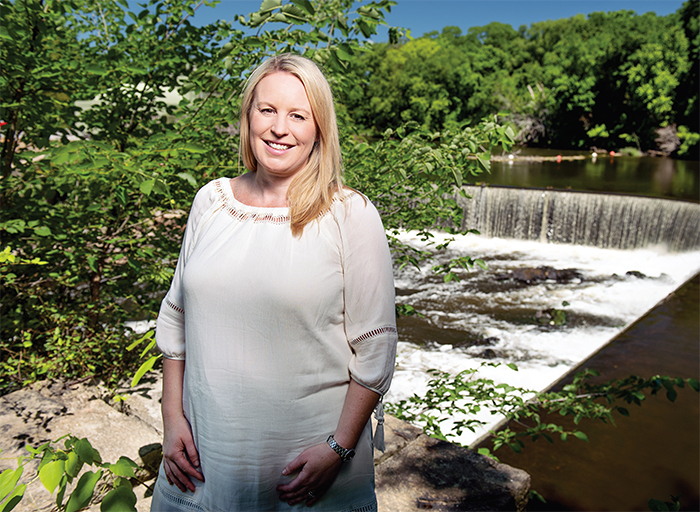
Photo: Webb Chappell
Jaclyn Leibl-Cote, MBA’15, is president of Collette, a 100-year-old travel company that’s based in Pawtucket, Rhode Island, in an office along the banks of the Blackstone River.
Collette also must keep up with travelers’ expectations, which have changed over time. “Travel used to be about the bucket list,” says Leibl-Cote. “People would want to see the Eiffel Tower. They would want to go to the Colosseum. People want experiences now. They want to meet people in a local village, to sit in a cafe, to do a cooking demonstration, to feel like they’re living like a local. We’re connecting people with culture, we’re connecting them with experiences.”
The ability to connect with a culture, to immerse oneself in it, is one of the main allures of travel for Leibl-Cote. “For me, travel is the biggest educator. It is a gift,” she says. “I live in Rhode Island. That would be a very small place to stay. You have to spread your wings and see what’s out there.” Leibl-Cote doesn’t make assumptions about a country or culture from what she sees in the media. “I see it with my own eyes,” she says. “When you go there and walk in the footsteps of people and talk to them, that can bridge stereotypes.” Leibl-Cote hopes all Collette customers take away such a deeper understanding of a place from their trips. “I hope they feel connected to the culture they visited, that they come back and have an appreciation of the people,” she says.
Nowadays, travelers can do so much of their own trip planning online, from booking hotels and flights to researching restaurants and sights to see, but sifting through the myriad choices the Internet provides can be difficult. That’s why the personal touch that Collette provides is still valued, says Leibl-Cote. “We had a record year in 2017,” she says. “We’re seeing upward trends in growth.”
Leibl-Cote is one of eight family members who work full time at Collette. Her grandfather bought the business in 1962, and she has worked there for much of her adult life. Her three children, twin 7-year-old boys and a 5-year-old girl, represent the company’s next generation. “They see the hard work that goes into it,” she says. “I do it for the three of them. It’s a family business. I want to pass it on to them.”
Of course, leaving the three of them to go on work trips isn’t easy. As much as Leibl-Cote loves to travel, as much as she loves adding another stamp to her passport, she also loves to come home. When her airplane lands at Boston’s Logan Airport and the pilot over the intercom says, “Welcome home,” she takes that to heart.
Sailing on the Wind
Ever since he was a boy, Robert Lahue ’99 wanted to take to the sea. For a long time, that dream was his alone. After graduating from Babson, however, he and his then-girlfriend, Betsy, sailed off the East Coast for a year. When that voyage was done, they looked to the future and vowed to sail again together one day. “I found someone who embraced my dream as well,” he says. “It became our dream.”
Robert and Betsy got married, had three boys, and built careers. She was an executive at a medical device manufacturer, while he was a real estate investor. They hadn’t forgotten about their dream of the sea, and in fact were setting aside 10 percent of their income every year toward making it happen. But still, time was passing. They felt settled in the New Jersey town they called home. Could they really uproot their family, walk away from their careers, and take off on a long sailing adventure? “We realized we have to do this before the motivation was lost,” Lahue says. “I wouldn’t have been happy with myself if we didn’t make it happen.”
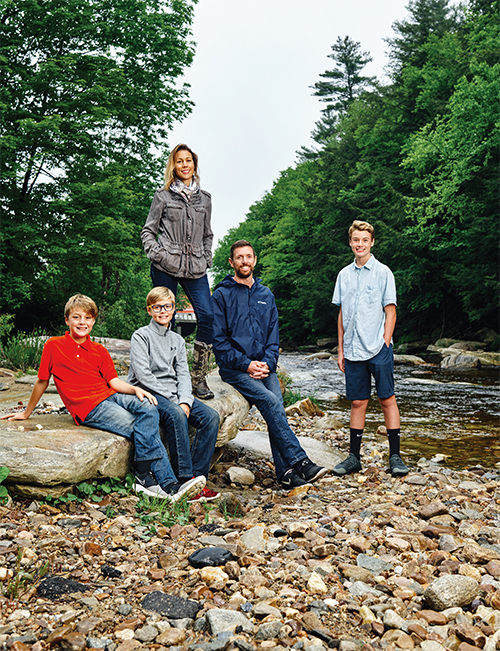
Photo: Douglas Levy
The Lahue family (left to right), J. Oliver, Myles, Betsy, Robert ’99, and Henry, now make their home in Stratton Mountain, Vermont, after spending nearly two years sailing aboard the Alkemi.
So they decided to go for it. Betsy quit her job, and Lahue began selling off his rental properties. They sold their house, and they bought a boat, a 45-foot sloop named Alkemi. Their boys, Henry, Myles, and J. Oliver, then ages 12, 10, and 8, looked forward to the upcoming journey with excitement, and their friends and family were left to marvel that the Lahues were actually doing it, that they were leaving everything behind to take the trip of a lifetime.
In the summer of 2016, the family moved aboard the Alkemi, sailing down the East Coast out of Maryland. Immediately after departing, the family relished all the time they suddenly had together. Back in New Jersey, their days had seemed so hectic, the adults with their careers and social obligations and the kids with their many activities. “We all had our own lives,” Lahue says. “We were getting to know each other again.”
Still, the relentless feeling of needing to keep busy took a long time to fade away. “We used to measure our day by how much we accomplished,” Lahue says. “It takes a while to get that out of your system.” Sailing to the Caribbean and then to Central and South America, Lahue says it wasn’t until the family reached Colombia, a good 11 months into the trip, that he finally was able to accept and ultimately embrace a slower pace of life. “We didn’t have to fill every moment anymore,” he says.
As life slowed down, the children relied more on their imaginations to amuse themselves. They read books and kept journals. One son played guitar, while another created an elaborate make-believe country. The family also made time for their faith, something that had slipped away from them in their busy lives in Jersey. Their return to spirituality was partly inspired by having time to sit, enjoy a sunset, look at the stars, and contemplate. But the family also came to rely on their faith when confronted with uncertain situations, such as during storms. The family once was caught in a gale with 12- to 15-foot waves, which crashed over the boat. While the children were kept safely below, the adults were on deck, watching the boat’s course. “You are wearing a life jacket and hooked in with a harness,” Lahue says. “My wife and I had to comfort and reassure each other. It was frightening.”
As the trip went on, the family traveled from Panama and Colombia, to Jamaica and the Cayman Islands, to Mexico, Cuba, and back to the U.S. Throughout the journey, the Lahues encountered a range of people. Lahue recalled how they became friendly with a family from Israel on another boat. “The kids didn’t know each other’s languages, but they played with each other a lot,” he says. As they made excursions on land, the Lahues also met people living in severe poverty. “Those kinds of experiences were good for the children to see,” Lahue says. “You get wrapped up in wanting things. It gives you a new perspective on your life.”
Finally, the trip came to an end this past April in Key West, Florida, and Alkemi was sold to a new owner. The adults felt like they could have continued on, but the boat was starting to feel smaller as the boys grew older and taller, says Lahue. The boys also were eager to return to a regular school after being home-schooled for two years on the boat.
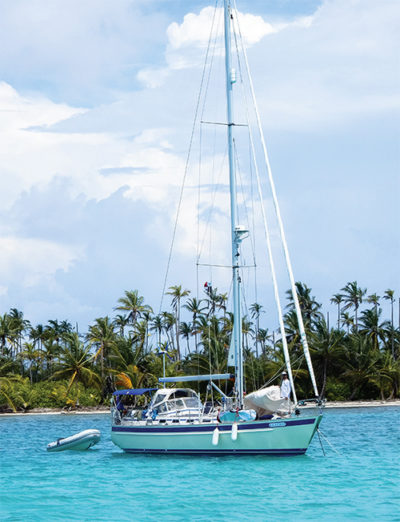
Photo Courtesy Robert Lahue ’99
The Lahues sailed aboard the Alkemi, a 45-foot sloop.
As he looks back on the voyage, a dream Lahue had harbored for so long, he thinks about how it turned out differently from what he had envisioned so many years earlier. “I thought it would be about seeing cool places and being in tropical destinations,” Lahue says, “but ultimately, it was about spending more time with family and learning to appreciate a simpler life.”
To hold on to that simpler, more laid-back lifestyle, the family has moved to their ski condo in Stratton Mountain, Vermont, and Robert and Betsy are now trying to figure out what the next step in their careers will be. They’re hoping to tackle an entrepreneurial opportunity.
They’re also hoping one day to return to the sea. Next time, they want to sail and explore the Pacific.
]]>